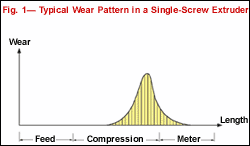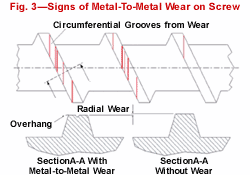Look Out for Metal-to-Metal Wear
Wear that occurs as a result of metal-to-metal contact in extruders is quite common.
Wear that occurs as a result of metal-to-metal contact in extruders is quite common. At its worst, it can bring a production line to a screeching halt. Less dramatically, wear can wreak havoc with process stability and cause nasty product contamination. Wear occurs in all machinery with moving parts, and extruders are no exception. So the question isn’t if wear will occur, but how fast.
Wear in extruders generally results in an increase in the clearance between screw flight and barrel. Most often, this occurs toward the end of the compression section of the screw (see Fig. 1). This type of wear is more likely to occur when the screw has a high compression ratio. Wear in the screw’s compression section reduces its melting capacity and will lead to melt-temperature and pressure fluctuations.
Wear can also occur in the metering section of the screw, which will have the effect of reducing the extruder’s pumping capacity. However, this drop is generally quite small, provided the wear does not exceed two to three times the design clearance. Increased flight clearance will also reduce the effectiveness of heat transfer from the barrel to the melt and vice versa. This will contribute to non-uniform temperatures in the melt, which lead to output fluctuations.
You need to disassemble the extruder and inspect the screw and barrel to detect wear, but there are telltale warning signs that problems are on the horizon. Also, you can determine how fast wear is progressing by regularly measuring the ID of the barrel and the OD of the screw over the length of the machine. By extrapolating to the maximum allowable wear, you can determine at what point in time the screw and/or barrel should be replaced or rebuilt.
If replacement as a result of wear is necessary after several years of operation, the easiest solution is, of course, to simply replace the worn parts. But if you’re in a situation where you find it necessary to replace your screws and barrels within much shorter periods, like several months or several weeks, you need to investigate other solutions. If you have short-term wear problems, the cost of downtime and replacement parts can easily become unacceptable, and your objective should be to reduce the actual wear rate instead of simply replacing the worn parts.
Detecting wear problems
Generally speaking, if you are experiencing poor control of melt temperature, higher melt temperature, and output variations, you might have a metal-to-metal wear problem. Loss of output usually will not result until the wear is quite severe. Wear problems are generally detected by metal particles collecting on the screen pack or in the extruded product itself (contamination). Also, if you start hearing unusual sounds—particularly grinding noises—from the extruder, wear might be the cause. High motor load and/or high temperatures along the extruder also can be signs of wear problems.
Let’s take a look at a couple of examples of wear in action to see the causes and effects of such a problem, along with what was (or should be) done to correct it.
Case 1: Contamination
Our first case occurred at a fiber producer that was operating several 3.5-in. extruders running PET. The extruders were equipped with barrier screws and had been in operation for several years without significant problems.
On one occasion, operators began to notice a sharp drop in output over a period of several hours. This caused an increase in screw speed because the extruder was connected to a number of gear pumps through a polymer header system, a common set-up in fiber spinning. As the screw’s conveying capacity dropped, the screw speed was increased automatically to maintain constant suction pressure at the gear pumps. Operators also noticed that the middle barrel zone started overriding by more than 20° C and the melt temperature at the discharge end of the extruder rose with the screw speed.
Operators first tweaked the barrel-temperature profile, but when that didn’t solve the problem, they pulled the screw. The screw and barrel were considerably worn at the end of the barrier section. Moreover, the barrier section was discolored blue and purple, a clear indication of very high metal temperatures in that region.
Operators found that a substantial amount of small metal pellets had collected at the end of the barrier section of the screw. Since the metal pellets were larger than the barrier-flight undercut, they could not pass beyond the barrier section. As a result, the particles jammed at the end of the barrier section, wedged between the root of the solids channel and the barrel.
Granted, this was a rather dramatic case—the suspected culprit was a metal rod that an operator inadvertently dropped down the machine throat. But the point is that screws with barrier sections can be more susceptible to serious wear problems when foreign particles contaminate the resin. When those nonmelting particles are larger than the barrier undercut, they will clump at the end of the barrier section (Fig. 2). Wedged between the screw and the barrel, they can cause serious damage.
Processors can safeguard against this by installing a magnetic metal trap below the hopper. However, metal traps do not offer complete safety because hard non-metallic particles can also damage the machine. It is better to use a trap that can capture all foreign particles before they get into the extruder.
Case 2: Screw deflection
This problem occurred on a 6-in. extruder in which output started dropping dramatically. Operators noticed that substantial amounts of metal particles were collecting at the screen pack, so they pulled the screw and saw it was severely worn. The screw showed clear signs of metal-to-metal contact: circumferential grooves in the screw flights and an overhang of the hardfacing (Fig. 3). The screw also showed the typical blue/purple discoloration in the region of most severe wear.
What was even more disturbing was the fact that other extruders came down with the same problem. The rate of wear was high enough that the screws did not last more than a few days before they were worn beyond acceptable limits.
It turned out that the cause of the problem was a seemingly innocent modification that was made to the extruders about six months before the wear problem occurred. A grooved liner had been added to the feed throat. The grooved liner increased the solids-conveying capacity of the screw, thereby improving output by about 10% and increasing process stability. However, the melting capacity of the screw was not changed, so unmelted plastic was being pushed farther down in the compression section of the screw. Since the screw had a relatively high compression ratio, the unmelted plastic in the compression section created a wedging action between the root of the screw and the barrel, resulting in screw deflection and metal-to-metal contact.
Surprisingly, it took about half a year before the wear rate became high enough to cause severe problems. When the effect of a change in the process takes such a long time to appear, it makes it more difficult to find the cause of the problem.
In this case it was decided to reduce the length of the grooves in the feed housing to reduce the pressure buildup in the compression section. This change completely eliminated the problem. The screws now run for at least five years before significant wear occurs.
Chris Rauwendaal has worked in extrusion for nearly 30 years. He heads his own engineering firm in Los Altos Hills, Calif., which provides screw and die designs as well as training and process troubleshooting services. The author can be contacted at chris@rauwendaal.com.
Related Content
What to Know About Your Materials When Choosing a Feeder
Feeder performance is crucial to operating extrusion and compounding lines. And consistent, reliable feeding depends in large part on selecting a feeder compatible with the materials and additives you intend to process. Follow these tips to analyze your feeder requirements.
Read MorePart 2 Medical Tubing: Use Simulation to Troubleshoot, Optimize Processing & Dies
Simulation can determine whether a die has regions of low shear rate and shear stress on the metal surface where the polymer would ultimately degrade, and can help processors design dies better suited for their projects.
Read MoreSingle vs. Twin-Screw Extruders: Why Mixing is Different
There have been many attempts to provide twin-screw-like mixing in singles, but except at very limited outputs none have been adequate. The odds of future success are long due to the inherent differences in the equipment types.
Read MoreMedical Tubing: Use Simulation to Troubleshoot, Optimize Processing & Dies
Extrusion simulations can be useful in anticipating issues and running “what-if” scenarios to size extruders and design dies for extrusion projects. It should be used at early stages of any project to avoid trial and error and remaking tooling.
Read MoreRead Next
Making the Circular Economy a Reality
Driven by brand owner demands and new worldwide legislation, the entire supply chain is working toward the shift to circularity, with some evidence the circular economy has already begun.
Read MoreBeyond Prototypes: 8 Ways the Plastics Industry Is Using 3D Printing
Plastics processors are finding applications for 3D printing around the plant and across the supply chain. Here are 8 examples to look for at NPE2024.
Read MoreLead the Conversation, Change the Conversation
Coverage of single-use plastics can be both misleading and demoralizing. Here are 10 tips for changing the perception of the plastics industry at your company and in your community.
Read More

















